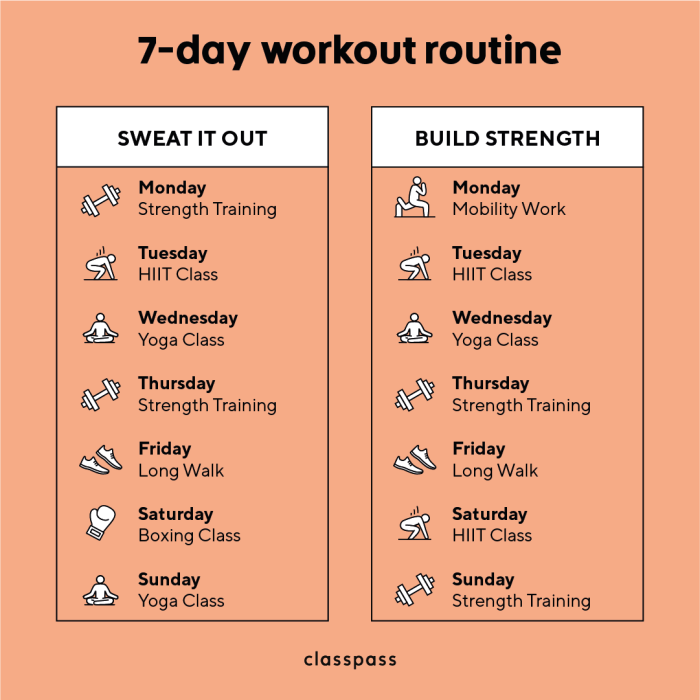Muscle Training Program: Building muscle isn’t just about lifting weights; it’s a science demanding precision and understanding. This guide delves into the intricacies of crafting a successful muscle-building regimen, exploring diverse training methodologies, exercise selection, nutritional strategies, and injury prevention techniques. We’ll examine everything from the optimal rep ranges for hypertrophy to the importance of progressive overload and periodization, empowering you to design a program tailored to your specific goals and fitness level.
From beginner-friendly full-body routines to advanced split programs, we’ll dissect the key components of effective muscle training, including warm-up protocols, exercise selection strategies, and recovery methods. We’ll also address common misconceptions and provide actionable advice, helping you navigate the often-confusing world of muscle building and achieve sustainable results.
Nutrition and Recovery

Optimizing nutrition and recovery is paramount for maximizing the benefits of any muscle training program. Failing to adequately fuel your body and allow for sufficient rest will hinder progress, leading to plateaus and potentially injury. This section details the crucial role of nutrition, sleep, stress management, and supplementation in achieving optimal muscle growth and recovery.Proper nutrition provides the building blocks for muscle repair and growth.
Sufficient protein intake is essential, as it supplies the amino acids necessary for muscle protein synthesis. Carbohydrates replenish glycogen stores, crucial for energy during workouts and preventing muscle breakdown. Healthy fats support hormone production and overall bodily function. A balanced macronutrient intake, coupled with micronutrients from fruits and vegetables, ensures optimal physiological function and supports the demands of intense training.
Dietary Strategies for Muscle Growth
A sample meal plan supporting a muscle training program should prioritize whole, unprocessed foods. This ensures a balanced intake of macronutrients and micronutrients, supporting both muscle growth and overall health. A typical daily plan might include: Breakfast: Oatmeal with berries and nuts; Lunch: Grilled chicken salad with mixed greens and olive oil; Dinner: Baked salmon with brown rice and steamed broccoli; Snacks: Greek yogurt, protein shake, or a handful of almonds.
Portion sizes should be adjusted based on individual caloric needs and training intensity. The focus should be on consistent, high-quality nutrition throughout the day, rather than relying on infrequent, large meals.
The Importance of Sleep and Stress Management
Sleep and stress management are often overlooked yet are critical components of muscle recovery. During sleep, the body releases growth hormone, crucial for muscle repair and growth. Chronic sleep deprivation significantly impairs this process, hindering muscle recovery and potentially leading to overtraining. Stress, on the other hand, elevates cortisol levels, a catabolic hormone that can break down muscle tissue.
Effective stress management techniques, such as meditation, yoga, or spending time in nature, are vital for optimizing recovery and preventing the negative impacts of stress hormones on muscle growth. Aim for 7-9 hours of quality sleep per night and incorporate regular stress-reducing activities into your routine.
The Role of Supplementation
Supplementation can play a supporting role in muscle growth and recovery, but it should not replace a balanced diet. Protein powder can be a convenient way to increase protein intake, particularly for individuals struggling to meet their daily requirements through whole foods. Creatine monohydrate is a well-researched supplement that has been shown to increase muscle strength and power. However, it’s crucial to choose high-quality supplements from reputable brands and to consult with a healthcare professional or registered dietitian before starting any supplementation regimen.
Remember, supplements are just that – supplements – they should complement, not replace, a healthy diet and training program. Over-reliance on supplements without addressing fundamental aspects of nutrition and training can be counterproductive.
Individual Needs and Considerations: Muscle Training Program

Tailoring a muscle training program to individual needs is crucial for maximizing results and minimizing injury risk. A standardized approach fails to account for the diverse physical capabilities, health conditions, and fitness goals of individuals. Effective programming requires a nuanced understanding of these factors and a willingness to adapt.
Fitness Goals and Program Design
Individual fitness goals significantly influence program design. Someone aiming for strength gains will follow a different regimen than someone focusing on endurance or flexibility. Strength training programs emphasize heavier weights and lower repetitions, while endurance programs prioritize higher repetitions with lighter weights. Flexibility goals require incorporating stretching and mobility exercises. Setting clear, measurable, achievable, relevant, and time-bound (SMART) goals is paramount to guide program development and track progress.
For example, a SMART goal might be “Increase bench press by 10 pounds in three months.” This provides a concrete target to measure success.
Age and Fitness Level Considerations
Age and fitness level are key determinants of exercise selection and intensity. Older adults, for instance, may benefit from programs that prioritize balance and mobility, using lighter weights and focusing on proper form to minimize the risk of falls and injuries. Conversely, highly trained athletes can handle more intense workouts with heavier loads and advanced techniques. Beginners should start with basic exercises and gradually increase intensity and complexity.
A phased approach, starting with bodyweight exercises and progressing to resistance training, is often recommended for novices. Consider a program that gradually increases the weight lifted, sets performed, and the overall training volume.
The Role of a Qualified Fitness Professional, Muscle Training Program
A qualified fitness professional plays a vital role in creating personalized programs. They conduct thorough assessments, considering medical history, current fitness levels, and individual goals. This assessment informs the design of a safe and effective program, including exercise selection, intensity, frequency, and rest periods. Professionals can also provide guidance on proper form, ensuring the exercises are performed correctly to maximize results and prevent injuries.
Moreover, they can adapt programs in response to individual progress and any unforeseen challenges. A certified personal trainer, for example, can modify a workout plan based on an individual’s response to the initial program, adjusting weight, reps, and sets to ensure continued progress and prevent plateaus.
Modifying Exercises for Limitations and Injuries
Individuals with specific limitations or injuries require modifications to standard exercises. For example, someone with knee problems might substitute squats with seated leg presses or modify push-ups to incline push-ups, reducing stress on the knees. Back injuries might necessitate avoiding deadlifts and opting for alternative exercises that target similar muscle groups without placing excessive strain on the spine.
A physical therapist or certified fitness professional can provide tailored modifications based on the specific condition. For instance, a person with a shoulder injury might modify bench presses by reducing the weight and focusing on controlled movements, potentially incorporating resistance bands for lighter resistance and increased range of motion. This ensures continued progress without exacerbating the injury.
Ultimately, a successful muscle training program is a personalized journey, requiring dedication, consistency, and a willingness to adapt. By understanding the principles Artikeld in this guide – from exercise selection and progressive overload to nutrition and recovery – you can build a foundation for long-term strength gains and overall fitness improvements. Remember to prioritize proper form, listen to your body, and consult with qualified professionals when necessary.
The path to achieving your physique goals is paved with informed choices and consistent effort.

